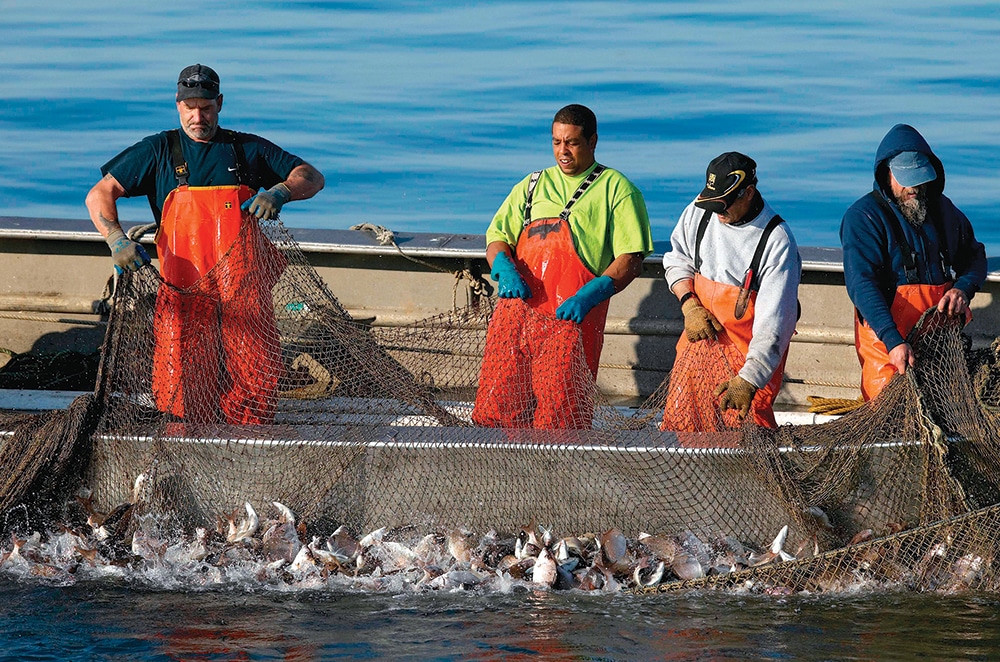
conservation package
As I write this, there is a lot of activity concerning the status of forage fish. Since they are important to recreational anglers, herring and menhaden seem to get most of the attention. A complete discussion on forage would include a much wider range of species, such as sand lance, anchovies, sardines and mackerel, to name a few. But I think I’ll at least narrow it down to the major ones impacting recreationally sought game fish.
erring, specifically river herring, are a hot topic all along the East Coast. It is just past that time of year when river wardens get to see what came back to rivers in towns all along the coast. Word has it that a bunch of rivers are looking good — not where they should be, but a heck of a lot better than they have been in the last few years. Some of this is due to in-stream restoration projects that are paying off, and some of it is due to efforts to minimize the high-seas interaction between sea herring and mackerel and so-called mid-water trawlers.
The in-stream work is fairly easy to measure. Restore the habitat in the watershed or rebuild or create fish-ladder access to spawning grounds, wait a couple of years and count the increase. These are prolific spawners that grow quickly, so gratification, while not instant, is pretty darn quick. A comment about Maine’s Penobscot River dam removal by Scott Phillips, owner of Northeast Outdoor Sports, is a perfect example: “Those alewives have been trying to get up the river forever. They just kept butting their heads against the dam. As soon as we opened it back up — boom! Ten years ago, they counted 47 alewives at the Veazie Trap. This year, it is already past 100,000 and counting.”
The at-sea bycatch interaction is a lot harder to measure for a number of reasons, but the main one is the sheer volume of fish caught in the sea herring fishery. It is fairly normal to have 200,000 pounds of herring and whatever else in a net. The other problem is that in the sea herring fishery, there is no requirement to weigh the catch when it is landed. The industry has resisted this as too onerous. Funny that a fishery like lobster in Maine has every one of the 125 million pounds weighed because it is deemed good business. If the truth be known, there probably is not a good handle on bycatch in general in the sea herring fishery. Regional fishery management councils have been working on it, but it has been an uphill battle.
No matter how well managers do, there will always be fluctuations in the population. The major consideration of scientists who advise the managers on setting catch levels should be leaving enough resources for predators such as tuna, striped bass, redfish, whales, codfish, and others to feed on.
As for menhaden, most of the catch of this forage species is in the mid-Atlantic and the Gulf of Mexico. There have not been any major migrations of menhaden, like we used to see in the 1980s, north of Cape Cod for a number of years. I keep hoping that there will be, as they bring a whole host of predators that like to feed on them. It appears that the Gulf States Marine Fisheries Commission has been doing a fairly good job managing the Gulf of Mexico menhaden stock.
Some steps have been implemented by the Atlantic States Marine Fisheries Commission to control the harvest of menhaden. For 2013 there was a 20 percent reduction over the average catch for 2009-2011. The biggest issue has been how this has been enforced, or not enforced, by different states.
Some states were many times over their allocations. A long list of folks will be pushing for a fair and equitable enforcement policy. There should also be measures that do not allow states such as Maryland to have a bycatch fishery after they reach their quota.
As fishery managers move toward ecosystem-based fishery management, quotas will have to reflect better the amount of forage needed by apex predators other than man. All of the natural uses should be taken off the top, and what is left can be allocated to human user groups.
We will have to see what the reduction does for overall population in the next couple of years. It would certainly be great to get back to the ’80s, when massive schools moved all the way up the Atlantic Coast. There were a lot of happy predators and a lot of happy anglers.
It should be obvious that sustainably managing forage species has implications far beyond the fish themselves. If managers allow forage stocks to collapse, many other species will quickly follow. Luckily, folks are paying attention, and it seems that things are moving in a positive direction. This might date me, but I am reminded of the old adage, “Mind the pennies and the dollars will take care of themselves.” The little fish, the forage species, are the pennies of the sea.









